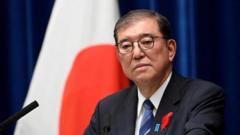In a pivotal election taking place today, Japanese voters are casting their ballots amidst growing dissatisfaction over increased living costs and looming tariffs from the United States. The ruling Liberal Democratic Party (LDP), accompanied by its junior partner Komeito, is aiming to secure a collective 50 seats to uphold its majority in the upper house. However, recent polls suggest the coalition may struggle to meet this target.
This election presents challenges for Prime Minister Shigeru Ishiba, especially as tensions escalate in trade discussions with US President Donald Trump. Japan's vital automobile sector, which employs around eight percent of the population, has already faced damaging tariffs, and the most recent trade figures have sparked concerns that the country's economy might be on the brink of a technical recession.
Despite Ishiba's efforts that included an early meeting with Trump and multiple visits from his trade envoy to Washington, a resolution between the two nations remains elusive. Japanese citizens are particularly worried about inflation, with the price of rice—considered a staple—nearly doubling over the past year. The government has resorted to using emergency food supplies to address shortages.
Voter confidence in the LDP has diminished since it fell short of a majority in last year's lower house election, with many constituents expressing discontent towards stagnant wage growth and ongoing inflation issues. Rising in prominence is the populist Sanseito party, appealing to younger generations through social media campaigns. Its slogan, "Japanese First," resonates with some conservative voters, despite its hardline approach to immigration and critiques of globalism and progressive policies.
Should Ishiba's coalition fail to achieve the requisite number of seats, it risks losing its parliamentary majority which could endanger his political standing and trigger instability within the government. Historically, the LDP has maintained a continuous grip on power since 1955, notwithstanding shifts in leadership. The last incidents where the LDP and Komeito did not win a parliamentary majority occurred in 2010 and 2007, which significantly altered Japan's political landscape, leading to the temporary rise of the now-defunct Democratic Party of Japan. As the election unfolds, the stakes remain exceptionally high for both Ishiba and the future of Japan's governance.
This election presents challenges for Prime Minister Shigeru Ishiba, especially as tensions escalate in trade discussions with US President Donald Trump. Japan's vital automobile sector, which employs around eight percent of the population, has already faced damaging tariffs, and the most recent trade figures have sparked concerns that the country's economy might be on the brink of a technical recession.
Despite Ishiba's efforts that included an early meeting with Trump and multiple visits from his trade envoy to Washington, a resolution between the two nations remains elusive. Japanese citizens are particularly worried about inflation, with the price of rice—considered a staple—nearly doubling over the past year. The government has resorted to using emergency food supplies to address shortages.
Voter confidence in the LDP has diminished since it fell short of a majority in last year's lower house election, with many constituents expressing discontent towards stagnant wage growth and ongoing inflation issues. Rising in prominence is the populist Sanseito party, appealing to younger generations through social media campaigns. Its slogan, "Japanese First," resonates with some conservative voters, despite its hardline approach to immigration and critiques of globalism and progressive policies.
Should Ishiba's coalition fail to achieve the requisite number of seats, it risks losing its parliamentary majority which could endanger his political standing and trigger instability within the government. Historically, the LDP has maintained a continuous grip on power since 1955, notwithstanding shifts in leadership. The last incidents where the LDP and Komeito did not win a parliamentary majority occurred in 2010 and 2007, which significantly altered Japan's political landscape, leading to the temporary rise of the now-defunct Democratic Party of Japan. As the election unfolds, the stakes remain exceptionally high for both Ishiba and the future of Japan's governance.






















